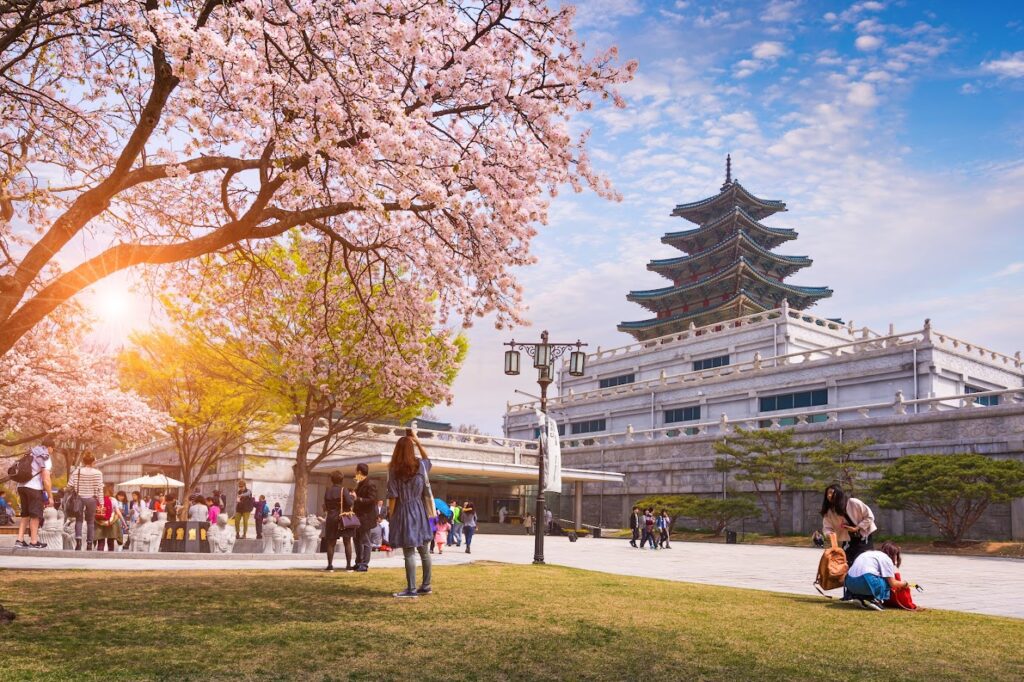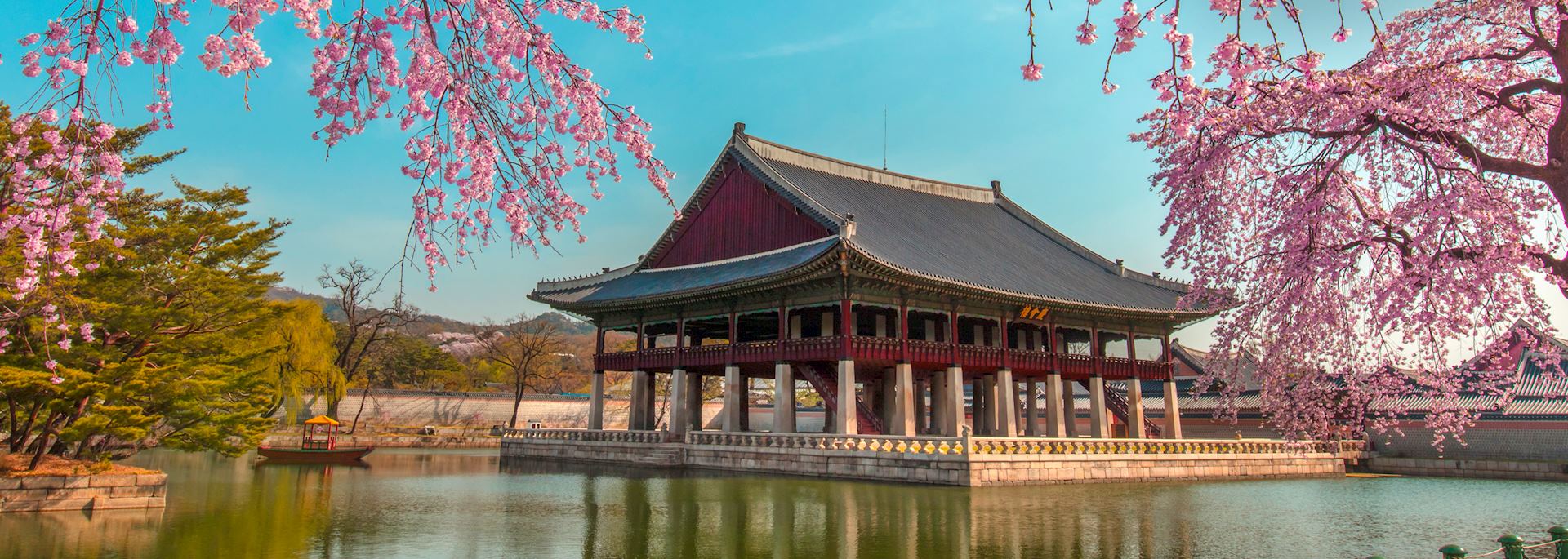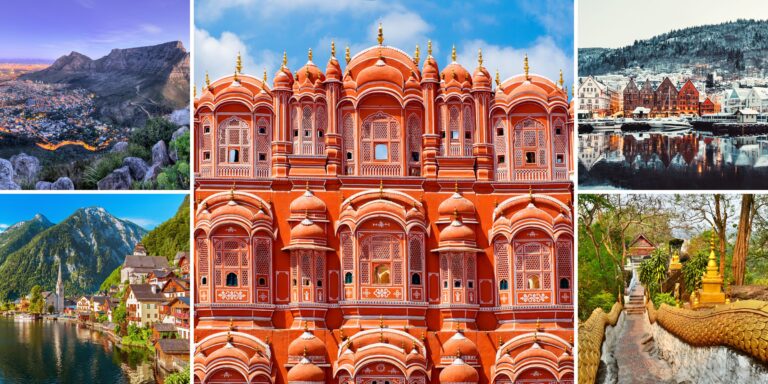South Korea enjoys four distinct seasons, each offering different attractions. In general, the spring months (March–May) and autumn (September–November) are widely regarded as the best time to visit South Korea, featuring mild temperatures and clear skies. Winter and summer have more extreme weather, but they also have unique draws (like skiing or beach festivals). This guide breaks down what to expect each season – from cherry blossoms in spring to snow festivals in winter – with tips for nature lovers, festival-goers, budget travelers, and families.
Best Time to Visit South Korea
Spring (March–May)
Spring in South Korea is a beautiful time of renewal. Average highs are a comfortable 15–18 °C, and the country’s parks and temples burst into bloom. The entire nation celebrates with flower festivals and outdoor activities. For example, Seoul’s parks and Jeju Island turn pink with cherry blossoms, and the country’s famous cherry blossom season (late March–early April) makes April one of the best months to visit.
- Nature lovers: Come see the iconic cherry blossoms. Seoul’s Yeouido Park, Gyeongju’s historic sites and the Jinhae region are famous for their cherry blossom festivals (Jinhae alone has ~350,000 cherry trees lining a scenic stream). Jeju Island, being further south, flowers even earlier – in April you’ll find miles of yellow canola fields (the Hangang Seoraeseom Canola Festival along the Han River in Seoul celebrates this bloom late April–May). Spring is also ideal for hiking: trails in national parks like Jirisan or Bukhansan are cool and green, and the famous Hwagae Cherry Blossom Trail lights up Mount Jirisan.
- Festival-goers: Spring is festival season. In late March/April, virtually every city has a cherry blossom festival (in addition to Jinhae, Seoul and Busan hold popular blossom events). In May, Seoul’s Lotus Lantern Festival (Yeondeunghoe) marks Buddha’s birthday with lantern parades and performances. The festival tradition dates back 1,200 years, filling the city with color. You can also attend flower-themed events like the Taean Tulip Festival and local Spring flower shows. For a truly unique spring ritual, Jeju’s old “Jeju Fire Festival” (held in late March) used to light ancient bonfires on the grass to welcome spring, though it was briefly canceled in 2024.
- Budget travelers: Spring is generally a popular tourist season, so prices in April can be higher. If you’re on a budget, consider traveling in late April or early May, after the cherry blossom crowds thin out. The weather is still pleasant (around 13–23 °C) and there are plenty of sunny days before the summer heat.
- Families: With mild weather and many school breaks, spring is great for families. Children delight in picnics under cherry trees and spring-themed amusement parks (Everland and Lotte World often decorate for spring). Note that late April includes a week of Korean holidays (Children’s Day on May 5th), so plan accommodations in advance.

Summer (June–August)
South Korea’s summer (June–August) is hot and humid, with average highs around 23–30 °C. It’s also the rainy season: heavy monsoon rains can drench the country from mid-June into July, bringing two-thirds of the year’s rainfall in a few weeks. By late July and August, temperatures can soar above 35 °C and humidity makes sightseeing uncomfortable. For these reasons, many travelers avoid peak summer; travel experts even recommend scheduling around monsoon season if possible.
- Nature lovers: Summer is best for sun and sea. Head to the southern coast – Busan’s Haeundae and Gyeongpo or Gangneung’s Jeongdongjin become beach playgrounds in July and August. The water is warm and clear. In the south, Jeju Island offers both beaches and lush hiking (though be prepared for sudden showers). Inland national parks (Seoraksan, Jirisan) are spectacularly green, but trails can be slippery and foggy after rain. If you can brave the humidity, waterfall hikes like Janggunbong on Jeju or Cheonjiyeon falls are rewarding in summer.
- Festival-goers: Summer has its own fun. Boryeong Mud Festival (late July) is one of Korea’s biggest summer events – at Daecheon Beach visitors cover themselves in mineral-rich mud, enjoy music concerts, and watch fireworks. Busan’s coast also hosts the Busan Sea Festival (around late July), a week-long seaside party with foam pools, sand art, and cultural performances. (For even more crowds, Busan’s Fireworks Festival in October is world-famous, but more on that in fall.) In Seoul and elsewhere, look for the annual water gun fights on city streets, and the Korea Fireworks Festival usually lights up the night in October – but sometimes there are smaller fireworks in summer too.
- Budget travelers: Summer is generally the most expensive time to visit South Korea. Flights, hotels and attractions charge peak rates with families and students on break. If you need to travel in summer, try to go in June, which is relatively cooler (nighttime lows are pleasant 18–27 °C) and just before the main rains and crowds. Many guides note that June has fewer tourists and lower prices than July/August. Avoid the intense rainy period in mid-July, and consider late August when typhoon season begins to clear (though storms can still happen).
- Families: Korean kids are on vacation, so summer sees many family trips and kids’ camps. Amusement parks (Everland, Lotte World) and water parks (Caribbean Bay, Seorak Waterpia) gear up for big crowds. Beach resorts often run family programs. Remember that high heat and sunburn are risks; pack SPF and stay hydrated. Many accommodations fill quickly, so booking early is a must. If you have flexibility, pick early June or late August to avoid the busiest holiday crowds.
Fall (September–November)
Autumn in South Korea is famously gorgeous. After the summer rains pass, the air cools and dries. October and November see comfortable days (roughly 7–16 °C) and brilliant foliage: “the whole country explodes with colors” of red, orange and yellow. This is a peak travel season; nature lovers and photographers flock to Seoraksan National Park, Nami Island, and temple areas like Boseong and Hwagae to hike among maple and ginkgo trees.
- Nature lovers: Fall foliage is the main draw. Mount Seorak and nearby areas like Osaek soak up the autumn colors around early October. Near Seoul, Gapyeong’s Nami Island and the Songnisan Arboretum offer stunning red maple paths. The historic city of Gyeongju is also lovely as its tombs and palace grounds turn golden. Don’t miss the misty morning views; some lakes freeze and create steamy scenes amid the leaves.
- Festival-goers: Fall brings some of Korea’s biggest cultural events. Chuseok (the Korean harvest moon festival) falls in September or early October; it’s a week when locals return home and hold traditional rituals under the full moon. You’ll see folk games, dance and special foods at village festivals (however, some shops close for the holiday). In late October, the Busan International Film Festival (BIFF) attracts movie buffs from around the world. Other highlights include the Andong Mask Dance Festival (late Sep) celebrating mask heritage, and harvest-related events like Gwangju’s Chunhyang Festival. Late autumn even has fireworks – Seoul’s Hangang Fireworks (usually early Oct) lights up the riverside, and Daegu hosts a color-themed festival with laser shows in early Oct.
- Budget travelers: Fall is shoulder season. Early September (after Chuseok) often has fewer crowds and deals on tours. October–November prices are moderate – cheaper than summer peaks but a bit higher than mid-fall. (For example, a Highlights Travel guide notes that September travel can be cheaper with fewer crowds.) If you want fall colors but are price-sensitive, plan for late November, when foliage fades and deals start.
- Families: Kids are back in school, so fall tends to be less hectic for families than summer. September can still have warm days great for outdoor play before it gets cold. If you have young children, the gentle weather is ideal for attractions like the Seoul Grand Park Zoo or autumn theme park events. Just watch for crowds on Chuseok week when families travel.

Winter (December–February)
Winter in South Korea is cold and dry – perfect for snowy landscapes and winter sports. Daytime temperatures in Seoul range around 0–4 °C in winter, and in the north (Gangwon Province) it can drop below –10 °C. Mountain areas see heavy snow, making now the best time for skiing, snowboarding and ice festivals.
- Nature lovers: Winter’s quiet beauty is best found in snow-covered parks and hot springs. Mount Halla on Jeju Island and Bukhansan near Seoul often have a light layer of snow. YongPyong and Alpensia resorts (host of the 2018 Winter Olympics) offer world-class ski slopes (see embed image above of YongPyong slopes). Even lakes and rivers freeze over – Hwacheon hosts a famous Sancheoneo Ice Festival in January, where you can fish through the ice and try raw trout dishes on the frozen river. Sunlight in winter is crisp and clear (the skies are often blue), so consider a snowy hike on well-maintained trails like the easy Dulle-gil trails in Gangwon.
- Festival-goers: Winter festivals are focused on snow and the holidays. Aside from ice fishing, look for the Taebaeksan Snow Festival (ice sculptures in January) and Pyeongchang Trout Festival (February). Lunar New Year (Seollal, late Jan/early Feb) is the biggest holiday: see traditional performances at royal palaces or temple fairs (kids can try folk games like yunnori). If you’re interested in a different vibe, Seoul’s holiday lights (everland and Lotte World winter lights, or Christmas markets in Gangnam) make for festive evenings.
- Budget travelers: Winter (especially January and February) is generally the cheapest time to visit South Korea. Flights and hotels drop prices after New Year’s until the Lunar holiday. If you don’t mind bundling up, you’ll find great deals and very few tourists in January (the rainiest months at highlightstravel.com note winter’s cold, dry weather but great discounts). Just be aware that Christmas/New Year (late Dec) can be pricier, so plan for late Jan or mid-Feb.
- Families: Winter breaks (mid-Dec and Lunar New Year) mean families travel for skiing trips. Ski resorts cater to kids with lessons and sledding parks. Many families also go to Jeju in winter – the island’s southern climate stays mild (around 10–15 °C) and without snow, making it a winter escape. Keep young children entertained with indoor attractions on cold days: Seoul’s COEX Aquarium, Lotte World’s indoor section, or Korea’s Science Museum in Daejeon.
Travel Tips and When to Avoid
- Monsoon caution: The main time to avoid South Korea is during the summer monsoon. July and early August see nearly constant rain and humid heat. If your schedule is flexible, try to skip the height of summer. Many guides recommend June instead: it’s warmer than spring but with far fewer downpours.
- Typhoon watch: Late August and early September can get typhoons from the Pacific, which bring heavy rain to the southern coast. Monitor weather if you travel in late summer. If a typhoon is forecast, shift your plans to Seoul or inland mountains (they usually get only rain).
- Worst and cheapest times: In short, the worst times climatically are July–August (hot/wet) and mid-January (freezing). The absolute cheapest time (excluding holiday spikes) is January–February, thanks to low demand.
- Regional highlights: Seoul: Year-round attractions (palaces, markets, museums) are great in any season; spring/fall have best weather. See our Seoul travel guide for city tips.
Busan: Summer is beach season in Busan (Haeundae, Gwangalli). In fall, Busan’s film festival and seafood make it exciting. Check Flyora’s Busan travel guide for local favorites.
Jeju Island: A year-round destination. Winter and early spring are ideal (mild weather and fewer crowds). The Jeju Cherry Blossom (Mar) and Canola (Apr) festivals are spectacular. See our Jeju travel tips for island advice.
Other areas: Consider Gyeongju in fall (historic temples with foliage), the mountain temple of Woljeongsa in winter (snowy Buddhist ceremonies), or Andong in September (Mask Dance Festival).
Plan your trip around what you most want to experience. In short, spring (late March–May) and autumn (October–November) are the safest bets for good weather. Families might appreciate school breaks, festival-goers will time for the celebrations they love, and nature lovers can chase cherry blossoms or fall leaves. By contrast, summer’s heat and rain is best for beach and festival outings, while winter suits snow sports and cultural holidays. Wherever you go, Flyora.travel has guides to help. Happy travels!





